Statistics in Education and Health Professions: Assignment 3 Analysis
VerifiedAdded on 2022/09/26
|5
|1326
|33
Homework Assignment
AI Summary
This assignment focuses on statistical analysis, specifically one-sample t-tests and z-tests, and their application in educational and health contexts. Part I involves a one-sample t-test on writing scores, including calculating the t-statistic, critical value, and confidence interval, and interpreting the p-value. It also includes making decisions about the null hypothesis based on these evidences. Part II explores a scenario involving a pilot study and a full-scale study to evaluate the impact of Power Physics on creativity, covering hypothesis formulation, standard error calculation, p-value interpretation, Type I error, and the use of z-scores. The assignment requires students to draw conclusions based on the statistical results, including effect size and power analysis, and to explain the meaning of statistical concepts in the context of the studies. The assignment also requires the use of SPSS output for data analysis and interpretation.
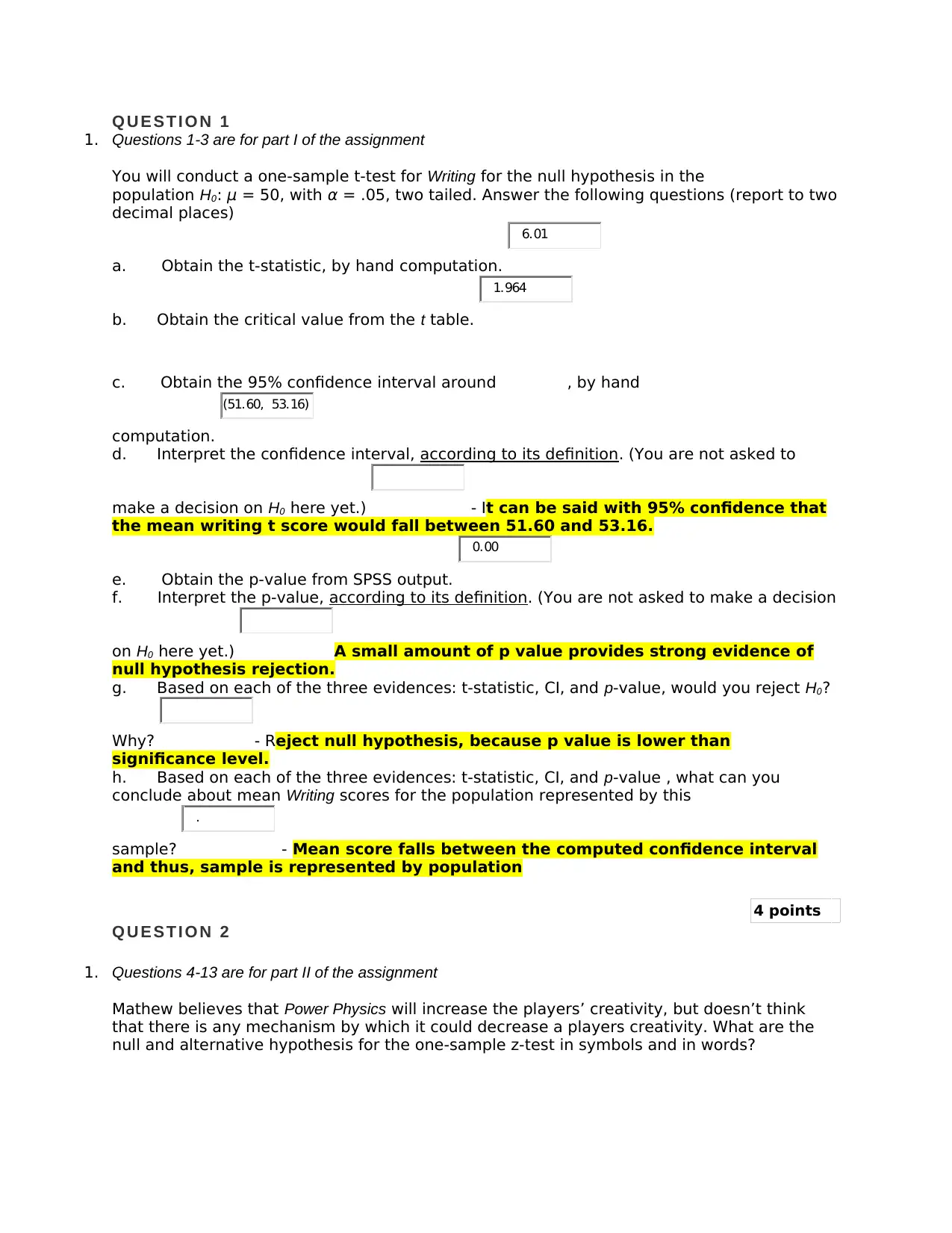
Q U E S T I O N 1
1. Questions 1-3 are for part I of the assignment
You will conduct a one-sample t-test for Writing for the null hypothesis in the
population H0: μ = 50, with α = .05, two tailed. Answer the following questions (report to two
decimal places)
a. Obtain the t-statistic, by hand computation.
b. Obtain the critical value from the t table.
c. Obtain the 95% confidence interval around , by hand
computation.
d. Interpret the confidence interval, according to its definition. (You are not asked to
make a decision on H0 here yet.) - It can be said with 95% confidence that
the mean writing t score would fall between 51.60 and 53.16.
e. Obtain the p-value from SPSS output.
f. Interpret the p-value, according to its definition. (You are not asked to make a decision
on H0 here yet.) A small amount of p value provides strong evidence of
null hypothesis rejection.
g. Based on each of the three evidences: t-statistic, CI, and p-value, would you reject H0?
Why? - Reject null hypothesis, because p value is lower than
significance level.
h. Based on each of the three evidences: t-statistic, CI, and p-value , what can you
conclude about mean Writing scores for the population represented by this
sample? - Mean score falls between the computed confidence interval
and thus, sample is represented by population
4 points
Q U E S T I O N 2
1. Questions 4-13 are for part II of the assignment
Mathew believes that Power Physics will increase the players’ creativity, but doesn’t think
that there is any mechanism by which it could decrease a players creativity. What are the
null and alternative hypothesis for the one-sample z-test in symbols and in words?
6.01
1.964
(51.60, 53.16)
0.00
.
1. Questions 1-3 are for part I of the assignment
You will conduct a one-sample t-test for Writing for the null hypothesis in the
population H0: μ = 50, with α = .05, two tailed. Answer the following questions (report to two
decimal places)
a. Obtain the t-statistic, by hand computation.
b. Obtain the critical value from the t table.
c. Obtain the 95% confidence interval around , by hand
computation.
d. Interpret the confidence interval, according to its definition. (You are not asked to
make a decision on H0 here yet.) - It can be said with 95% confidence that
the mean writing t score would fall between 51.60 and 53.16.
e. Obtain the p-value from SPSS output.
f. Interpret the p-value, according to its definition. (You are not asked to make a decision
on H0 here yet.) A small amount of p value provides strong evidence of
null hypothesis rejection.
g. Based on each of the three evidences: t-statistic, CI, and p-value, would you reject H0?
Why? - Reject null hypothesis, because p value is lower than
significance level.
h. Based on each of the three evidences: t-statistic, CI, and p-value , what can you
conclude about mean Writing scores for the population represented by this
sample? - Mean score falls between the computed confidence interval
and thus, sample is represented by population
4 points
Q U E S T I O N 2
1. Questions 4-13 are for part II of the assignment
Mathew believes that Power Physics will increase the players’ creativity, but doesn’t think
that there is any mechanism by which it could decrease a players creativity. What are the
null and alternative hypothesis for the one-sample z-test in symbols and in words?
6.01
1.964
(51.60, 53.16)
0.00
.
Paraphrase This Document
Need a fresh take? Get an instant paraphrase of this document with our AI Paraphraser
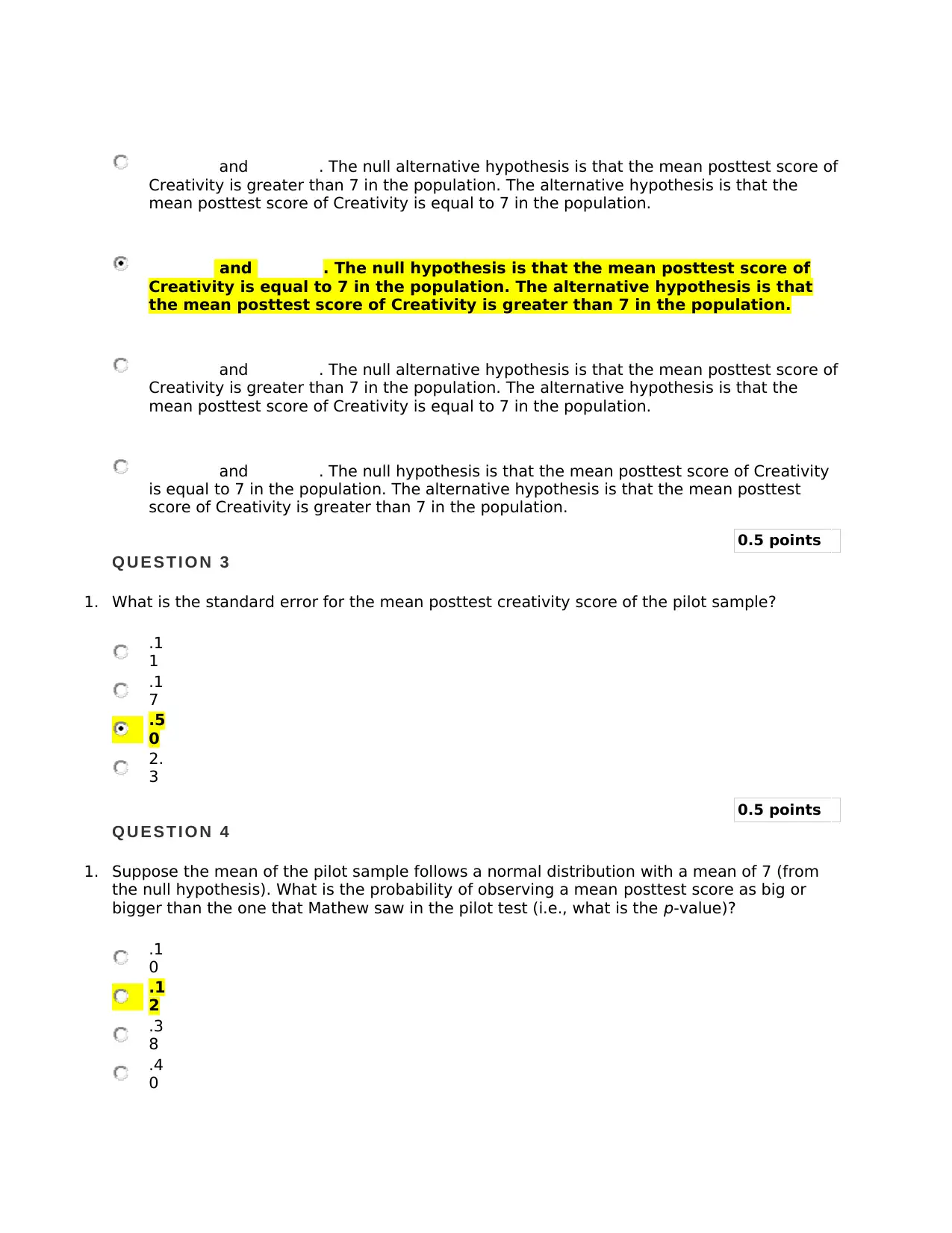
and . The null alternative hypothesis is that the mean posttest score of
Creativity is greater than 7 in the population. The alternative hypothesis is that the
mean posttest score of Creativity is equal to 7 in the population.
and . The null hypothesis is that the mean posttest score of
Creativity is equal to 7 in the population. The alternative hypothesis is that
the mean posttest score of Creativity is greater than 7 in the population.
and . The null alternative hypothesis is that the mean posttest score of
Creativity is greater than 7 in the population. The alternative hypothesis is that the
mean posttest score of Creativity is equal to 7 in the population.
and . The null hypothesis is that the mean posttest score of Creativity
is equal to 7 in the population. The alternative hypothesis is that the mean posttest
score of Creativity is greater than 7 in the population.
0.5 points
Q U E S T I O N 3
1. What is the standard error for the mean posttest creativity score of the pilot sample?
.1
1
.1
7
.5
0
2.
3
0.5 points
Q U E S T I O N 4
1. Suppose the mean of the pilot sample follows a normal distribution with a mean of 7 (from
the null hypothesis). What is the probability of observing a mean posttest score as big or
bigger than the one that Mathew saw in the pilot test (i.e., what is the p-value)?
.1
0
.1
2
.3
8
.4
0
Creativity is greater than 7 in the population. The alternative hypothesis is that the
mean posttest score of Creativity is equal to 7 in the population.
and . The null hypothesis is that the mean posttest score of
Creativity is equal to 7 in the population. The alternative hypothesis is that
the mean posttest score of Creativity is greater than 7 in the population.
and . The null alternative hypothesis is that the mean posttest score of
Creativity is greater than 7 in the population. The alternative hypothesis is that the
mean posttest score of Creativity is equal to 7 in the population.
and . The null hypothesis is that the mean posttest score of Creativity
is equal to 7 in the population. The alternative hypothesis is that the mean posttest
score of Creativity is greater than 7 in the population.
0.5 points
Q U E S T I O N 3
1. What is the standard error for the mean posttest creativity score of the pilot sample?
.1
1
.1
7
.5
0
2.
3
0.5 points
Q U E S T I O N 4
1. Suppose the mean of the pilot sample follows a normal distribution with a mean of 7 (from
the null hypothesis). What is the probability of observing a mean posttest score as big or
bigger than the one that Mathew saw in the pilot test (i.e., what is the p-value)?
.1
0
.1
2
.3
8
.4
0
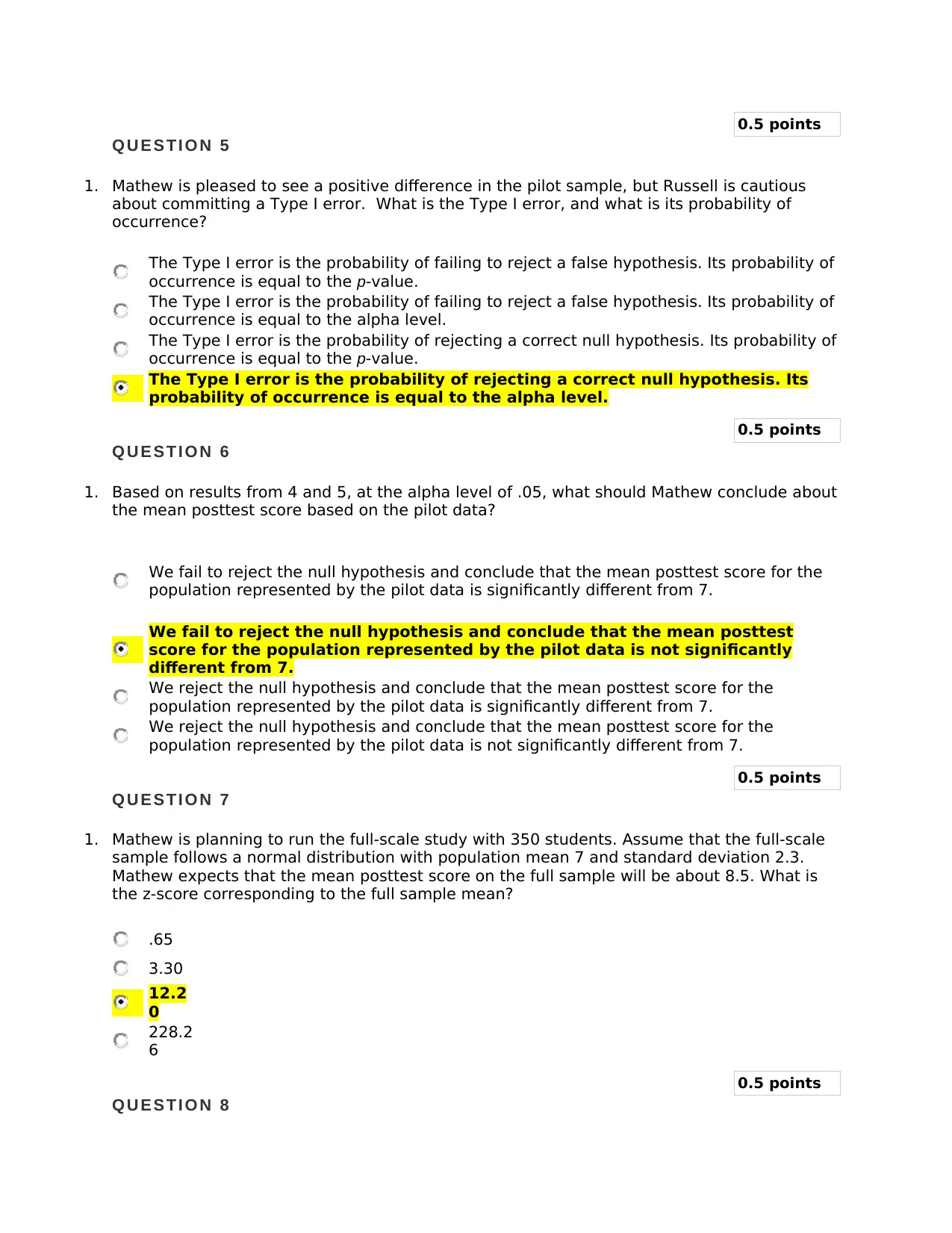
0.5 points
Q U E S T I O N 5
1. Mathew is pleased to see a positive difference in the pilot sample, but Russell is cautious
about committing a Type I error. What is the Type I error, and what is its probability of
occurrence?
The Type I error is the probability of failing to reject a false hypothesis. Its probability of
occurrence is equal to the p-value.
The Type I error is the probability of failing to reject a false hypothesis. Its probability of
occurrence is equal to the alpha level.
The Type I error is the probability of rejecting a correct null hypothesis. Its probability of
occurrence is equal to the p-value.
The Type I error is the probability of rejecting a correct null hypothesis. Its
probability of occurrence is equal to the alpha level.
0.5 points
Q U E S T I O N 6
1. Based on results from 4 and 5, at the alpha level of .05, what should Mathew conclude about
the mean posttest score based on the pilot data?
We fail to reject the null hypothesis and conclude that the mean posttest score for the
population represented by the pilot data is significantly different from 7.
We fail to reject the null hypothesis and conclude that the mean posttest
score for the population represented by the pilot data is not significantly
different from 7.
We reject the null hypothesis and conclude that the mean posttest score for the
population represented by the pilot data is significantly different from 7.
We reject the null hypothesis and conclude that the mean posttest score for the
population represented by the pilot data is not significantly different from 7.
0.5 points
Q U E S T I O N 7
1. Mathew is planning to run the full-scale study with 350 students. Assume that the full-scale
sample follows a normal distribution with population mean 7 and standard deviation 2.3.
Mathew expects that the mean posttest score on the full sample will be about 8.5. What is
the z-score corresponding to the full sample mean?
.65
3.30
12.2
0
228.2
6
0.5 points
Q U E S T I O N 8
Q U E S T I O N 5
1. Mathew is pleased to see a positive difference in the pilot sample, but Russell is cautious
about committing a Type I error. What is the Type I error, and what is its probability of
occurrence?
The Type I error is the probability of failing to reject a false hypothesis. Its probability of
occurrence is equal to the p-value.
The Type I error is the probability of failing to reject a false hypothesis. Its probability of
occurrence is equal to the alpha level.
The Type I error is the probability of rejecting a correct null hypothesis. Its probability of
occurrence is equal to the p-value.
The Type I error is the probability of rejecting a correct null hypothesis. Its
probability of occurrence is equal to the alpha level.
0.5 points
Q U E S T I O N 6
1. Based on results from 4 and 5, at the alpha level of .05, what should Mathew conclude about
the mean posttest score based on the pilot data?
We fail to reject the null hypothesis and conclude that the mean posttest score for the
population represented by the pilot data is significantly different from 7.
We fail to reject the null hypothesis and conclude that the mean posttest
score for the population represented by the pilot data is not significantly
different from 7.
We reject the null hypothesis and conclude that the mean posttest score for the
population represented by the pilot data is significantly different from 7.
We reject the null hypothesis and conclude that the mean posttest score for the
population represented by the pilot data is not significantly different from 7.
0.5 points
Q U E S T I O N 7
1. Mathew is planning to run the full-scale study with 350 students. Assume that the full-scale
sample follows a normal distribution with population mean 7 and standard deviation 2.3.
Mathew expects that the mean posttest score on the full sample will be about 8.5. What is
the z-score corresponding to the full sample mean?
.65
3.30
12.2
0
228.2
6
0.5 points
Q U E S T I O N 8
⊘ This is a preview!⊘
Do you want full access?
Subscribe today to unlock all pages.

Trusted by 1+ million students worldwide
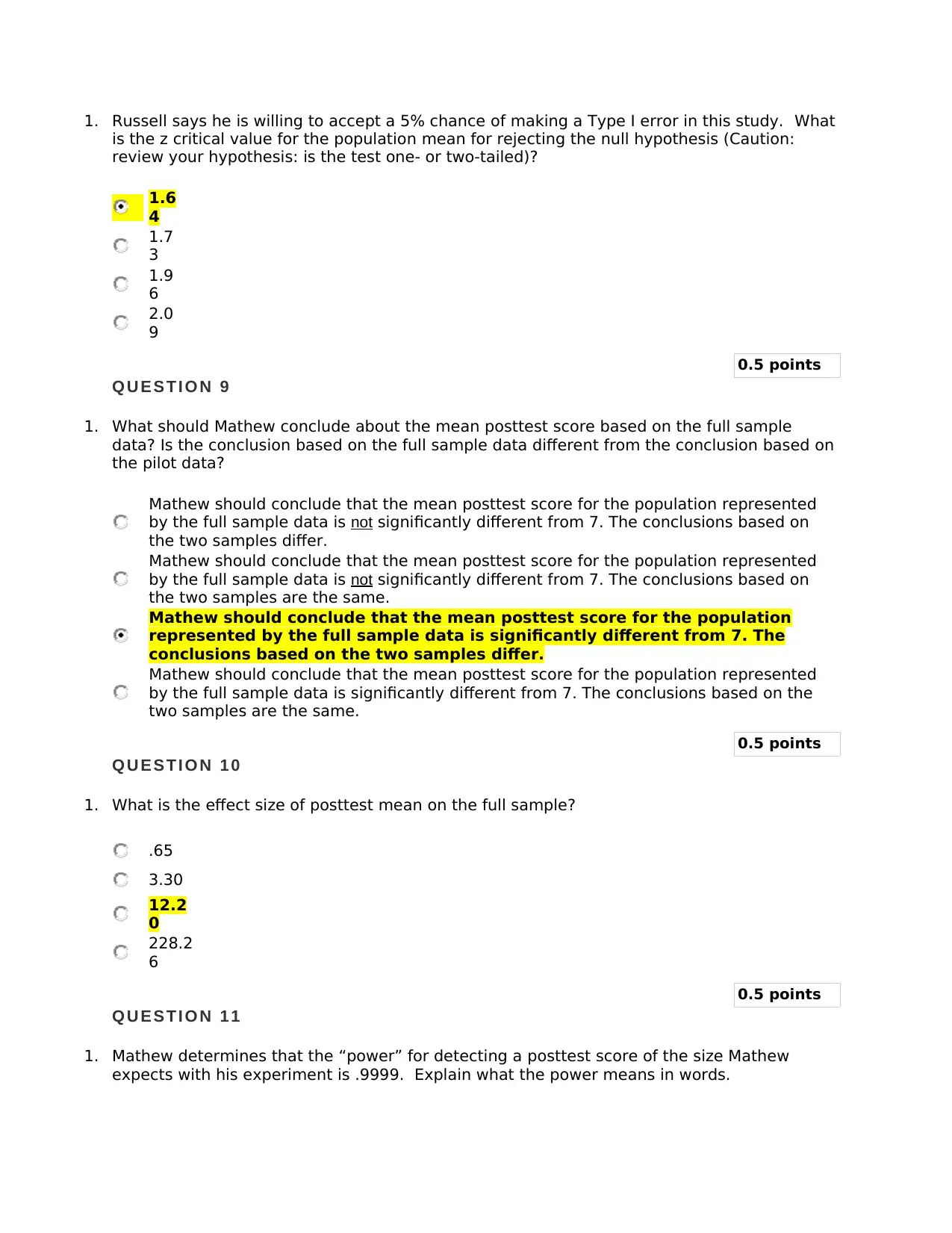
1. Russell says he is willing to accept a 5% chance of making a Type I error in this study. What
is the z critical value for the population mean for rejecting the null hypothesis (Caution:
review your hypothesis: is the test one- or two-tailed)?
1.6
4
1.7
3
1.9
6
2.0
9
0.5 points
Q U E S T I O N 9
1. What should Mathew conclude about the mean posttest score based on the full sample
data? Is the conclusion based on the full sample data different from the conclusion based on
the pilot data?
Mathew should conclude that the mean posttest score for the population represented
by the full sample data is not significantly different from 7. The conclusions based on
the two samples differ.
Mathew should conclude that the mean posttest score for the population represented
by the full sample data is not significantly different from 7. The conclusions based on
the two samples are the same.
Mathew should conclude that the mean posttest score for the population
represented by the full sample data is significantly different from 7. The
conclusions based on the two samples differ.
Mathew should conclude that the mean posttest score for the population represented
by the full sample data is significantly different from 7. The conclusions based on the
two samples are the same.
0.5 points
Q U E S T I O N 1 0
1. What is the effect size of posttest mean on the full sample?
.65
3.30
12.2
0
228.2
6
0.5 points
Q U E S T I O N 1 1
1. Mathew determines that the “power” for detecting a posttest score of the size Mathew
expects with his experiment is .9999. Explain what the power means in words.
is the z critical value for the population mean for rejecting the null hypothesis (Caution:
review your hypothesis: is the test one- or two-tailed)?
1.6
4
1.7
3
1.9
6
2.0
9
0.5 points
Q U E S T I O N 9
1. What should Mathew conclude about the mean posttest score based on the full sample
data? Is the conclusion based on the full sample data different from the conclusion based on
the pilot data?
Mathew should conclude that the mean posttest score for the population represented
by the full sample data is not significantly different from 7. The conclusions based on
the two samples differ.
Mathew should conclude that the mean posttest score for the population represented
by the full sample data is not significantly different from 7. The conclusions based on
the two samples are the same.
Mathew should conclude that the mean posttest score for the population
represented by the full sample data is significantly different from 7. The
conclusions based on the two samples differ.
Mathew should conclude that the mean posttest score for the population represented
by the full sample data is significantly different from 7. The conclusions based on the
two samples are the same.
0.5 points
Q U E S T I O N 1 0
1. What is the effect size of posttest mean on the full sample?
.65
3.30
12.2
0
228.2
6
0.5 points
Q U E S T I O N 1 1
1. Mathew determines that the “power” for detecting a posttest score of the size Mathew
expects with his experiment is .9999. Explain what the power means in words.
Paraphrase This Document
Need a fresh take? Get an instant paraphrase of this document with our AI Paraphraser
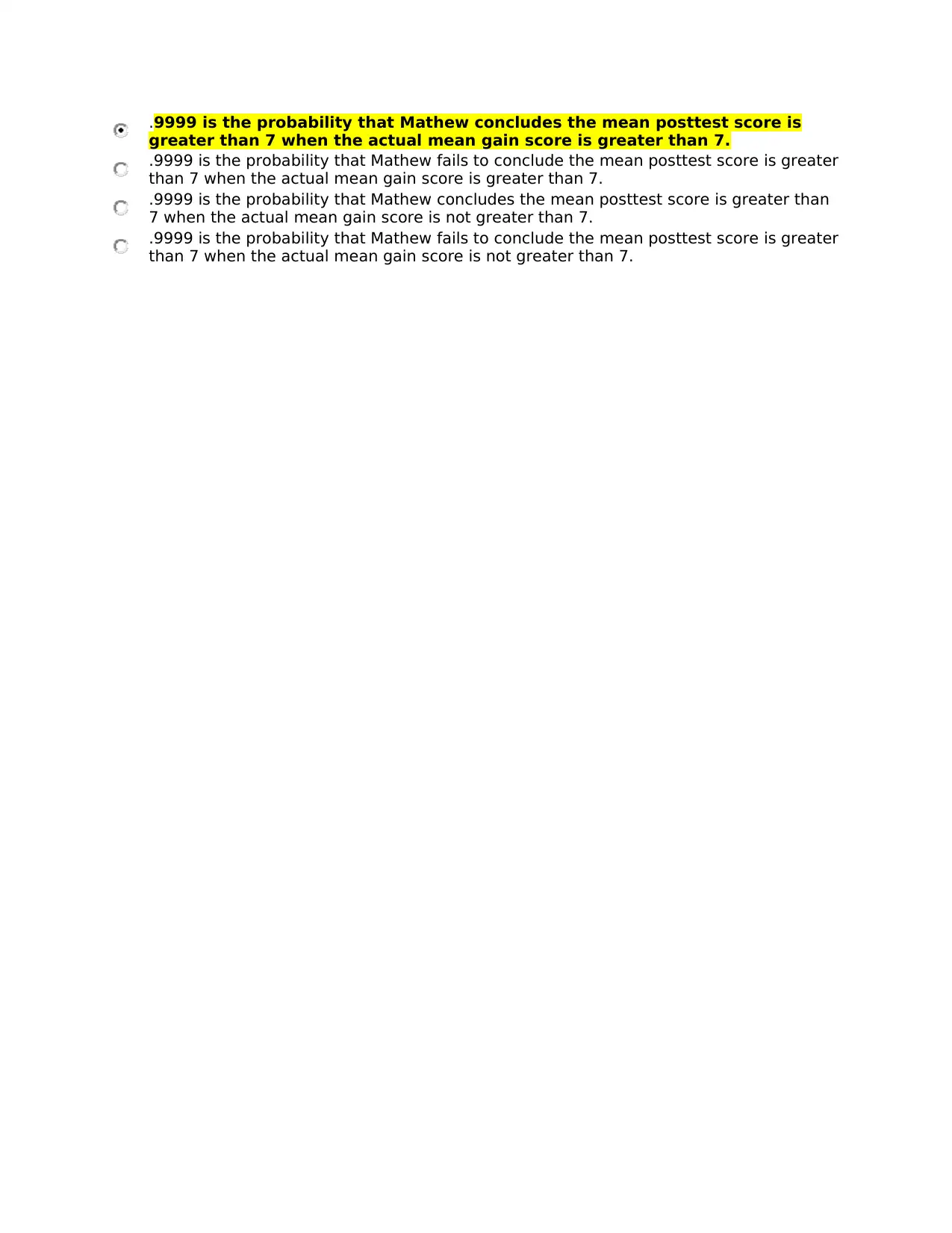
.9999 is the probability that Mathew concludes the mean posttest score is
greater than 7 when the actual mean gain score is greater than 7.
.9999 is the probability that Mathew fails to conclude the mean posttest score is greater
than 7 when the actual mean gain score is greater than 7.
.9999 is the probability that Mathew concludes the mean posttest score is greater than
7 when the actual mean gain score is not greater than 7.
.9999 is the probability that Mathew fails to conclude the mean posttest score is greater
than 7 when the actual mean gain score is not greater than 7.
greater than 7 when the actual mean gain score is greater than 7.
.9999 is the probability that Mathew fails to conclude the mean posttest score is greater
than 7 when the actual mean gain score is greater than 7.
.9999 is the probability that Mathew concludes the mean posttest score is greater than
7 when the actual mean gain score is not greater than 7.
.9999 is the probability that Mathew fails to conclude the mean posttest score is greater
than 7 when the actual mean gain score is not greater than 7.
1 out of 5
Related Documents
Your All-in-One AI-Powered Toolkit for Academic Success.
+13062052269
info@desklib.com
Available 24*7 on WhatsApp / Email
![[object Object]](/_next/static/media/star-bottom.7253800d.svg)
Unlock your academic potential
Copyright © 2020–2025 A2Z Services. All Rights Reserved. Developed and managed by ZUCOL.





